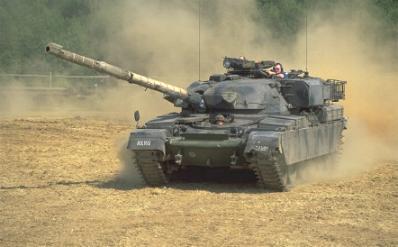

Manufacturer: Royal Ordnance, Leeds, England; and Vickers Defence Systems, Newcastle Upon Tyne, England.
The Chieftain replaced the successful Centurion as Britain’s main battle tank. The first prototypes ran in 1959, though the first vehicles did not enter service until the early 1970s.
The Chieftain’s design placed firepower and protection at a higher priority than performance or agility.
The Mk X features a computerised fire control system — using an exceptionally robust and primitive computer, with not a chip in sight — and a stabilised main gun. Front line versions have their searchlight removed, and are fitted with the Thermal Observation and Gunnery Sight.
The Chieftain has two engines: one to drive the tank, and a smaller generator engine. The main engine is the Leyland L60 two-stroke multi-fuel unit, with twelve opposed pistons in six cylinders. Development of this unit was beset with problems, and it did not achieve its specified 750hp until late in its production life.
Production of the Chieftain ceased in 1978, but a version of it — called the Khalid, and fitted with a Perkins Condor 1200hp engine — was sold to Jordan in 1981. The Challenger 1 main battle tank, which entered service in 1983, is a development of the Chieftain (or, rather, of the Khalid).
Engine: Leyland L60 6-cylinder (12-piston) liquid-cooled two-stroke multi-fuel producing 750hp at 2100rpm
Maximum speed: 48km/h
Fuel capacity & range: 950l, 400+km
Armament: 120mm main gun, 7.62mm MG coaxial, 7.62mm MG (commander’s cupola), 2x6 smoke grenade dischargers
Combat weight: 55.0t
Length: 7.518m excluding gun (10.795m gun forwards)
Width: 3.504m
Height: 2.895m
Crew: four